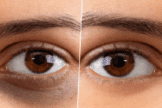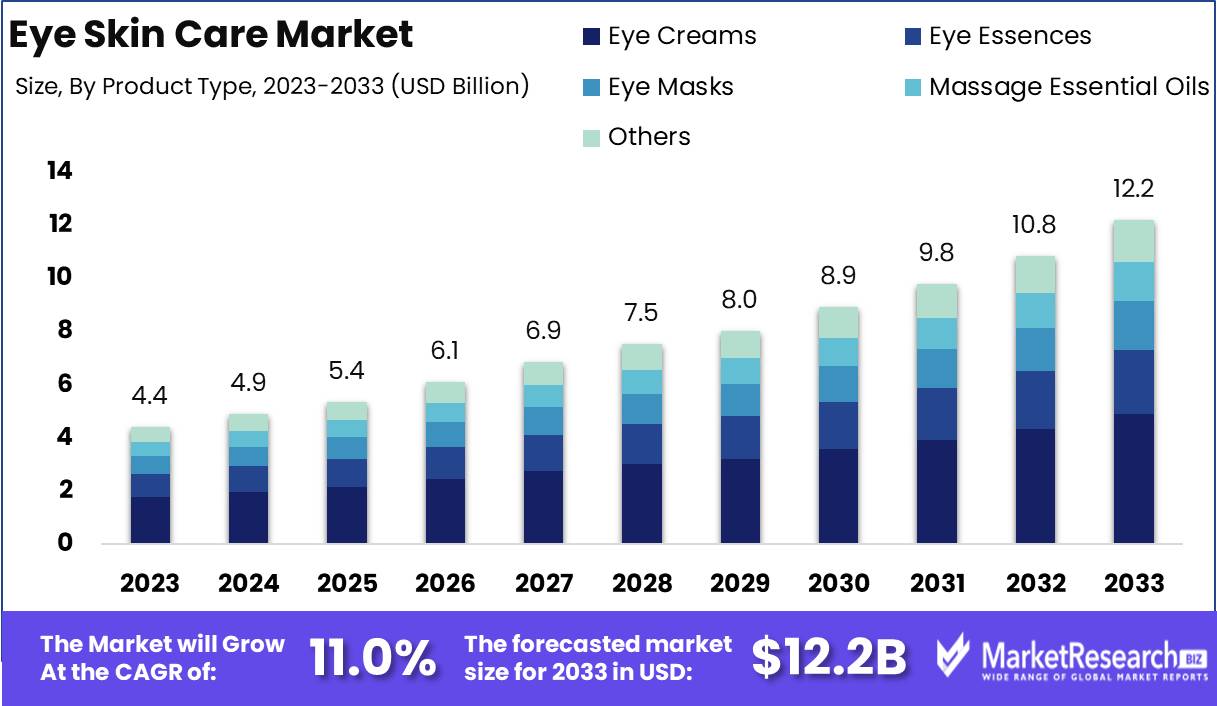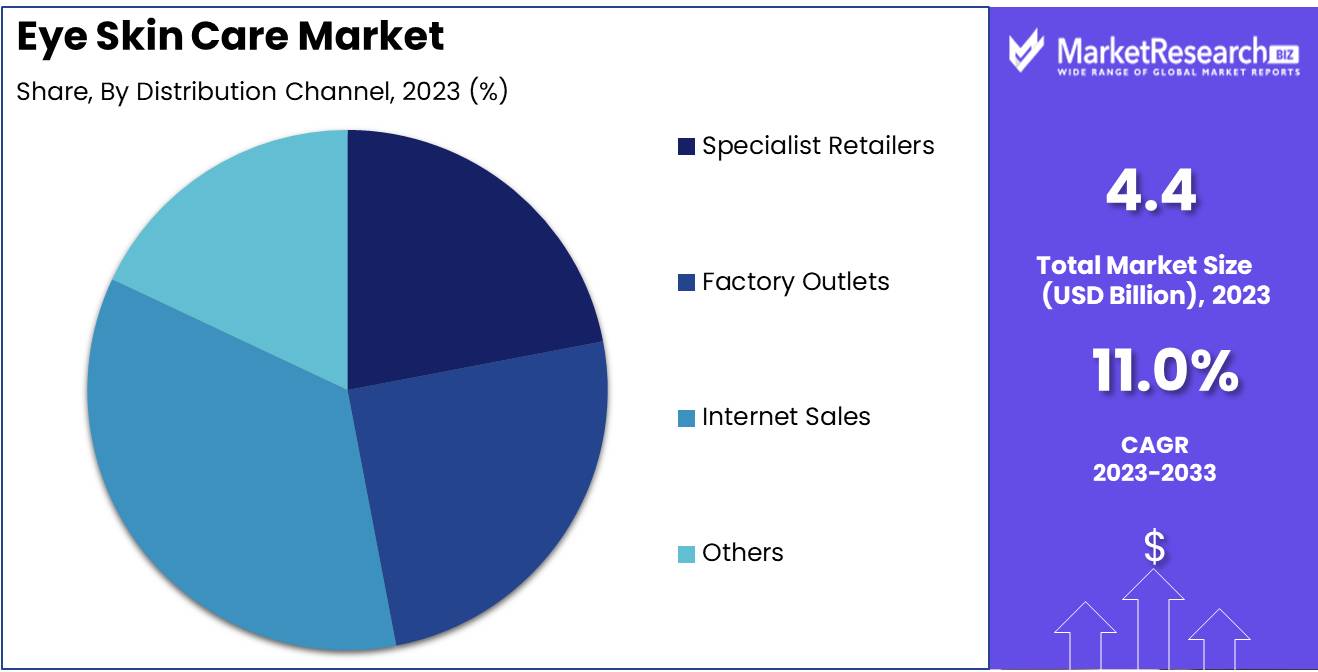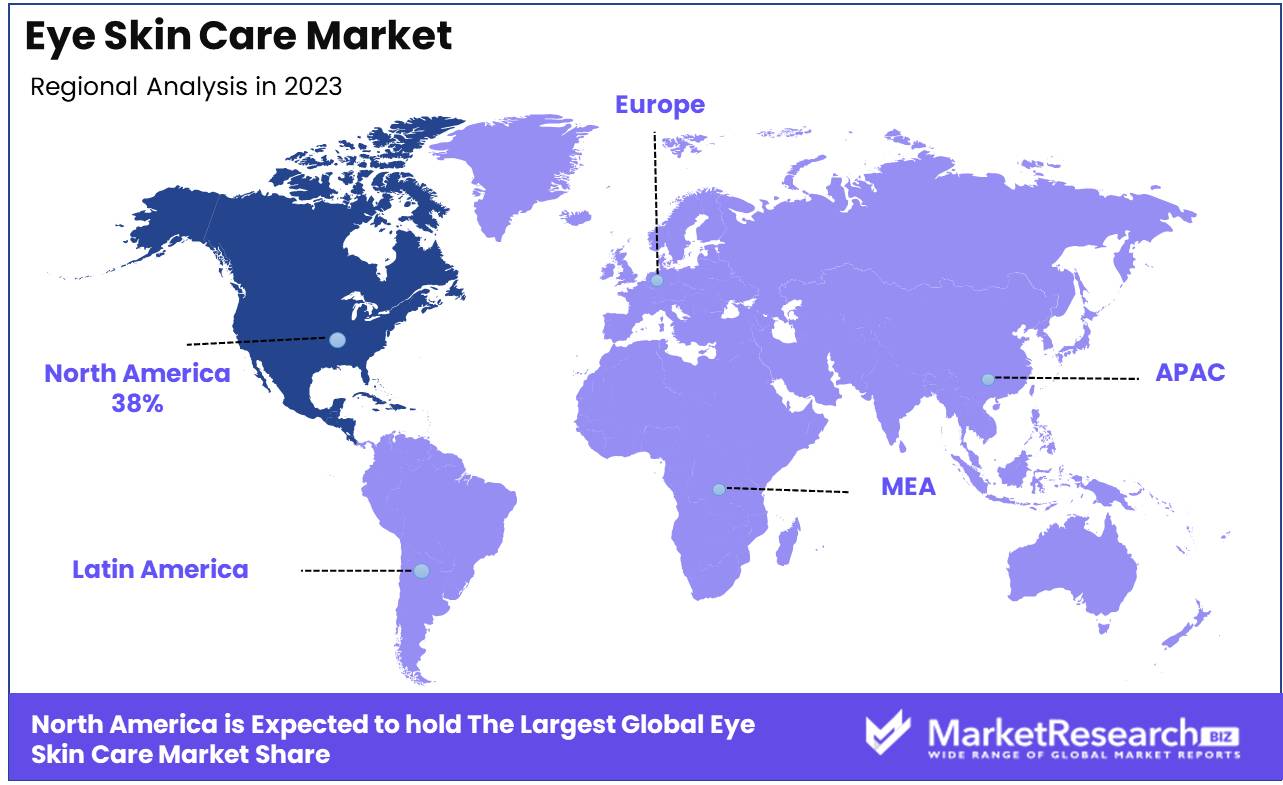
Eye Skin Care Market By Product Type (Eye Creams, Eye Essences, Eye Masks, Massage Essential Oils, Others), By Distribution Channel (Specialist Retailers, Factory Outlets, Internet Sales, Others), By Region and Companies - Industry Segment Outlook, Market Assessment, Competition Scenario, Trends and Forecast 2024-2033
-
23863
-
July 2024
-
150
-
-
This report was compiled by Trishita Deb Trishita Deb is an experienced market research and consulting professional with over 7 years of expertise across healthcare, consumer goods, and materials, contributing to over 400 healthcare-related reports. Correspondence Team Lead- Healthcare Linkedin | Detailed Market research Methodology Our methodology involves a mix of primary research, including interviews with leading mental health experts, and secondary research from reputable medical journals and databases. View Detailed Methodology Page
-
Quick Navigation
Report Overview
The Global Eye Skin Care Market was valued at USD 298 Mn in 2023. It is expected to reach USD 8208.7 Mn by 2033, with a CAGR of 40.5% during the forecast period from 2024 to 2033.
The Eye Skin Care Market focuses on products specifically designed to care for the delicate skin around the eyes. This market includes a range of treatments such as creams, serums, and masks that target issues like dark circles, puffiness, fine lines, and wrinkles. Driven by increasing consumer awareness and demand for specialized skincare solutions, this market leverages ingredients like ginseng, retinol, and hyaluronic acid to enhance skin appearance and health. Continuous innovation and a growing emphasis on anti-aging and hydration are key factors driving the market’s expansion.
 The Eye Skin Care Market is experiencing robust growth, fueled by rising consumer demand for targeted skincare solutions that address specific concerns around the delicate eye area. Products containing advanced ingredients such as ginseng and retinol have become particularly popular, with a notable 20% increase in consumer interest attributed to their proven efficacy in reducing wrinkles and improving skin elasticity. These ingredients are highly regarded for their ability to rejuvenate the skin, making them staples in modern eye care formulations.
The Eye Skin Care Market is experiencing robust growth, fueled by rising consumer demand for targeted skincare solutions that address specific concerns around the delicate eye area. Products containing advanced ingredients such as ginseng and retinol have become particularly popular, with a notable 20% increase in consumer interest attributed to their proven efficacy in reducing wrinkles and improving skin elasticity. These ingredients are highly regarded for their ability to rejuvenate the skin, making them staples in modern eye care formulations.Furthermore, the market has seen a significant uptick in the demand for hyaluronic acid-based products. Known for its exceptional moisture-retaining properties, hyaluronic acid can hold up to 1,000 times its weight in water. This capability leads to a 25% improvement in skin hydration and a noticeable reduction in puffiness, making it a favored ingredient in eye creams and serums. The effectiveness of these products in delivering visible results has spurred their adoption among consumers seeking to maintain youthful and healthy-looking skin.
The Eye Skin Care Market is poised for continued growth as consumers increasingly prioritize specialized skincare routines. Innovations in formulation and the introduction of new, effective ingredients are expected to further drive market expansion. Brands that can effectively communicate the benefits of their products and demonstrate their efficacy are likely to gain a competitive edge in this dynamic market. As the focus on eye-specific skincare continues to intensify, the market is set to witness sustained growth, offering promising opportunities for both established and emerging players.
Key Takeaways
- Market Value: The Global Eye Skin Care Market was valued at USD 298 Mn in 2023. It is expected to reach USD 8208.7 Mn by 2033, with a CAGR of 40.5% during the forecast period from 2024 to 2033.
- By Product Type: Eye Creams dominate with 40%, addressing specific skin concerns around the eyes.
- By Distribution Channel: Internet Sales account for 35%, reflecting the convenience and wide reach of online shopping.
- Regional Dominance: North America holds a 38% market share, driven by high consumer awareness and disposable income.
- Growth Opportunity: Introducing products with advanced formulations targeting specific skin issues can drive significant growth in the eye skin care market.
Driving factors
Growing Need for Advanced Data Analysis and Interpretation
The eye skin care market is increasingly driven by the growing need for advanced data analysis and interpretation. As consumers become more knowledgeable about skincare, they demand products that deliver proven results. Companies are leveraging advanced data analysis to understand customer preferences, skin types, and the effectiveness of different ingredients.
This data-driven approach allows for the development of targeted and personalized eye skin care products, enhancing customer satisfaction and loyalty. By utilizing sophisticated data analysis techniques, brands can refine their product formulations and marketing strategies to better meet consumer needs, thereby driving market growth.
Increasing Volumes of Complex Data
The increasing volumes of complex data in the eye skin care market are a significant growth driver. With the proliferation of digital platforms, wearable devices, and skincare apps, vast amounts of data are generated daily. This data includes consumer reviews, purchase histories, and skin health metrics. Companies can harness this complex data to gain insights into emerging trends, consumer behaviors, and product performance.
The ability to process and analyze large datasets enables brands to stay ahead of market trends, identify unmet needs, and innovate new products that cater to specific consumer demands. This data-centric approach is crucial for maintaining competitiveness and fostering growth in the eye skin care market.
Advancements in AI and Machine Learning Algorithms
Advancements in AI and machine learning algorithms are revolutionizing the eye skin care market. These technologies enable the development of intelligent systems that can predict skin conditions, recommend personalized skincare routines, and optimize product formulations. AI-powered tools can analyze skin images, detect issues such as dark circles and puffiness, and suggest appropriate treatments.
Machine learning algorithms can also predict market trends and consumer preferences with high accuracy, allowing companies to make informed decisions about product development and marketing strategies. By incorporating AI and machine learning, brands can offer highly effective and personalized solutions, thereby increasing consumer trust and driving market expansion.
Restraining Factors
High Cost of Implementation
The high cost of implementation presents a significant challenge for the growth of the eye skin care market. Developing advanced data analysis tools and integrating AI and machine learning algorithms require substantial investment in technology and infrastructure. Companies must allocate resources for purchasing sophisticated software, maintaining hardware, and hiring skilled professionals who can manage and interpret complex data.
Smaller companies and startups, in particular, may find these costs prohibitive, limiting their ability to compete with larger, well-funded organizations. The financial burden of implementing these advanced technologies can slow down the pace of innovation and restrict the market's overall growth potential.
Data Privacy and Security Concerns
Data privacy and security concerns are critical retraining factors in the eye skin care market. The collection and analysis of personal data, such as skin health metrics and consumer behavior patterns, necessitate stringent measures to protect sensitive information. Consumers are increasingly aware of privacy issues and expect companies to safeguard their data against breaches and misuse.
Regulatory frameworks, such as the General Data Protection Regulation (GDPR) and the California Consumer Privacy Act (CCPA), impose strict requirements on data handling and protection. Ensuring compliance with these regulations requires significant investment in security infrastructure and continuous monitoring. Failure to address these concerns can lead to legal penalties, reputational damage, and loss of consumer trust, thereby hindering the adoption of advanced data-driven technologies in the market.
By Product Type
Eye Creams held a dominant market position in the By Product Type segment of the Eye Skin Care Market, capturing more than a 40% share.
In 2023, Eye Creams held a dominant market position in the By Product Type segment of the Eye Skin Care Market, capturing more than a 40% share. The dominance of eye creams is driven by their widespread use in addressing common eye area concerns such as dark circles, puffiness, fine lines, and wrinkles. Eye creams are formulated with specific ingredients that provide hydration, reduce signs of aging, and improve the overall appearance of the delicate skin around the eyes.
Eye Essences are also significant in the market, known for their lightweight textures and concentrated active ingredients. These products are often used in conjunction with eye creams to enhance their efficacy. Despite their growing popularity, eye essences hold a smaller market share compared to eye creams due to their more specialized use.
Eye Masks offer intensive treatments and are popular for providing quick and visible results. They are used to rejuvenate and refresh the eye area, often preferred for their convenience and immediate effects. While important, the market share for eye masks is less dominant than eye creams because they are typically used less frequently.
Massage Essential Oils are utilized for their therapeutic benefits, helping to relax the eye area and reduce tension. These oils are part of a niche segment within the eye skin care market, catering to consumers who prefer natural and holistic approaches to skin care.
Others include a variety of eye skin care products such as serums, gels, and patches. These products address specific concerns and provide targeted treatments, but collectively hold a smaller market share compared to the primary categories.
By Distribution Channel
Internet Sales held a dominant market position in the By Distribution Channel segment of the Eye Skin Care Market, capturing more than a 35% share.
In 2023, Internet Sales held a dominant market position in the By Distribution Channel segment of the Eye Skin Care Market, capturing more than a 35% share. The growing preference for online shopping is driven by the convenience, wider product selection, and competitive pricing available through e-commerce platforms. Consumers benefit from the ability to compare products, read reviews, and access exclusive online discounts.
Specialist Retailers also hold a substantial share in the market, providing expert advice and a personalized shopping experience. These retailers offer a curated selection of high-quality eye skin care products and cater to consumers looking for specific brands and formulations.
Factory Outlets are favored for their discounted prices and direct access to products from manufacturers. These outlets attract cost-conscious consumers looking for value deals on premium products. Despite their appeal, factory outlets hold a smaller market share relative to internet sales due to their physical presence and limited accessibility.
Others include department stores, drugstores, and multi-brand beauty retailers that offer a wide range of eye skin care products. These channels are essential for reaching a diverse customer base but collectively hold a smaller share compared to the dominant internet sales and specialist retailers.

Key Market Segments
By Product Type
- Eye Creams
- Eye Essences
- Eye Masks
- Massage Essential Oils
- Others
By Distribution Channel
- Specialist Retailers
- Factory Outlets
- Internet Sales
- Others
Growth Opportunity
Development of AI-Driven Visualization Tools for Real-Time Data Analysis
The development of AI-driven visualization tools for real-time data analysis presents a significant opportunity for the global eye skin care market in 2024. These advanced tools enable companies to quickly interpret vast amounts of data, providing immediate insights into consumer behavior, product performance, and emerging trends. Real-time data analysis allows for more agile decision-making, enabling brands to swiftly adjust their strategies in response to market changes.
AI-driven visualization tools can help identify the most effective ingredients for different skin types, optimize product formulations, and personalize marketing efforts. This real-time capability enhances the precision and effectiveness of eye skin care products, driving consumer satisfaction and loyalty.
Expansion in Sectors Such as Finance, Healthcare, and Marketing
The expansion of AI and data analytics technologies into sectors such as finance, healthcare, and marketing offers new growth avenues for the eye skin care market. In the healthcare sector, advanced data analysis and AI-driven tools can be used to develop more effective treatments for eye-related skin conditions, providing tailored solutions based on individual patient data. In finance, better data analytics can optimize supply chain management, reduce costs, and improve profitability for eye skin care brands.
In the marketing sector, personalized and targeted advertising powered by AI can significantly enhance customer engagement and conversion rates. The cross-sectoral application of these technologies not only drives innovation within the eye skin care market but also opens up new collaborative opportunities that can further boost market growth.
Latest Trends
Use of Generative AI for Creating Dynamic and Interactive Visualizations
In 2024, the use of generative AI for creating dynamic and interactive visualizations is expected to be a key trend in the global eye skin care market. Generative AI enables the development of sophisticated visual content that can effectively convey complex data and insights to both consumers and industry professionals. Dynamic visualizations can illustrate the effects of different eye skin care products on various skin types, enhancing consumer understanding and engagement.
These interactive tools can also be used in marketing campaigns to create personalized experiences that resonate with individual users, thereby increasing customer loyalty and conversion rates. As generative AI continues to advance, its application in creating compelling and educational visual content will become increasingly prevalent, driving growth and innovation in the eye skin care market.
Integration with Business Intelligence Platforms for Enhanced Decision-Making
Another significant trend in 2024 is the integration of eye skin care data with business intelligence (BI) platforms for enhanced decision-making. BI platforms enable companies to aggregate and analyze data from various sources, providing a comprehensive view of market trends, consumer behavior, and operational performance. By integrating AI-driven data analysis with BI tools, eye skin care brands can gain deeper insights into their market dynamics and make more informed decisions.
This integration allows for real-time tracking of product performance, identification of emerging trends, and optimization of marketing strategies. Enhanced decision-making capabilities facilitated by BI platforms can lead to improved product development, more targeted marketing efforts, and better resource allocation, ultimately driving market growth.
Regional Analysis
North America dominated the Eye Skin Care Market, capturing a 42% market share.
In 2023, North America dominated the Eye Skin Care Market, capturing a significant market share of around 42%. This leadership is driven by high consumer awareness of skincare, the presence of major beauty and skincare brands, and significant spending on premium eye care products. The region benefits from strong retail and e-commerce infrastructures, facilitating wide accessibility to various eye skin care products. Innovations in product formulations and the rising popularity of natural and organic products further enhance market growth in North America.
Europe holds a substantial share in the eye skin care market, with countries like France, Germany, and the UK being major contributors. The market is characterized by high consumer awareness and demand for advanced skincare products, supported by a strong presence of luxury brands and innovative product offerings.
Asia Pacific is experiencing rapid growth, driven by increasing disposable incomes, growing beauty consciousness, and the expanding middle class in countries like China, Japan, and South Korea. The region benefits from a booming cosmetics industry and a high demand for effective eye care solutions.
Middle East & Africa show promising potential, with a rising focus on skincare and beauty products. The market is supported by increasing urbanization and growing consumer awareness of skincare benefits.
Latin America is emerging as a growing market for eye skin care products, with Brazil and Mexico leading the demand. The region benefits from increasing beauty consciousness and the rising availability of premium skincare products.

Key Regions and Countries
North America
- US
- Canada
- Mexico
Western Europe
- Germany
- France
- The UK
- Spain
- Italy
- Portugal
- Ireland
- Austria
- Switzerland
- Benelux
- Nordic
- Rest of Western Europe
Eastern Europe
- Russia
- Poland
- The Czech Republic
- Greece
- Rest of Eastern Europe
APAC
- China
- Japan
- South Korea
- India
- Australia & New Zealand
- Indonesia
- Malaysia
- Philippines
- Singapore
- Thailand
- Vietnam
- Rest of APAC
Latin America
- Brazil
- Colombia
- Chile
- Argentina
- Costa Rica
- Rest of Latin America
Middle East & Africa
- Algeria
- Egypt
- Israel
- Kuwait
- Nigeria
- Saudi Arabia
- South Africa
- Turkey
- United Arab Emirates
- Rest of MEA
Key Players Analysis
The Eye Skin Care Market in 2024 is characterized by intense competition and innovation, driven by key players such as Procter & Gamble Company, Unilever plc, L’Oréal S.A., Colgate-Palmolive, The Estée Lauder Companies Inc., Kao Corp., Shiseido Co., Ltd, Beiersdorf AG, Avon Products, Inc., and Eye Care Cosmetics. Procter & Gamble Company leverages its extensive R&D capabilities to develop advanced eye care formulations that cater to diverse consumer needs. Unilever plc focuses on sustainable and ethically sourced ingredients, appealing to environmentally conscious consumers.
L’Oréal S.A. continues to lead with its cutting-edge technology and extensive product portfolio, offering innovative solutions for eye skin care. Colgate-Palmolive is expanding its presence in the eye care segment with products that combine efficacy and affordability. The Estée Lauder Companies Inc. remains a key player with its premium brands that emphasize luxury and performance in eye care products.
Kao Corp. and Shiseido Co., Ltd bring their expertise in skincare and cosmetics from Japan, introducing products that incorporate traditional and modern ingredients for optimal eye care. Beiersdorf AG, known for its Nivea brand, continues to innovate with effective and affordable eye care solutions. Avon Products, Inc. emphasizes direct sales and personalized customer experiences, offering a wide range of eye care products.
Eye Care Cosmetics focuses on specialized formulations that address specific eye skin care concerns, carving a niche in the market. Other players in the market are also driving innovation and growth, making the Eye Skin Care Market highly competitive and dynamic in 2024.
Market Key Players
- Procter & Gamble Company
- Unilever plc
- L’Oréal S.A.
- Colgate-Palmolive
- The Estée Lauder Companies Inc.
- Kao Corp.
- Shiseido Co., Ltd
- Beiersdorf AG
- Avon Products, Inc.
- Eye Care Cosmetics
- Others
Recent Development
- In January 2024, L’Oréal S.A. launched a new eye cream line infused with advanced peptides to reduce wrinkles and puffiness. This product aims to attract consumers seeking effective anti-aging solutions.
- In May 2024, Shiseido Co., Ltd. invested $20 million in research and development to create innovative eye skin care formulations. This investment aims to enhance product efficacy and meet consumer demands for high-quality skincare.
Report Scope
Report Features Description Market Value (2023) USD 298 Mn Forecast Revenue (2033) USD 8208.7 Mn CAGR (2024-2033) 40.5% Base Year for Estimation 2023 Historic Period 2018-2023 Forecast Period 2024-2033 Report Coverage Revenue Forecast, Market Dynamics, Competitive Landscape, Recent Developments Segments Covered By Product Type (Eye Creams, Eye Essences, Eye Masks, Massage Essential Oils, Others), By Distribution Channel (Specialist Retailers, Factory Outlets, Internet Sales, Others) Regional Analysis North America - The US, Canada, & Mexico; Western Europe - Germany, France, The UK, Spain, Italy, Portugal, Ireland, Austria, Switzerland, Benelux, Nordic, & Rest of Western Europe; Eastern Europe - Russia, Poland, The Czech Republic, Greece, & Rest of Eastern Europe; APAC - China, Japan, South Korea, India, Australia & New Zealand, Indonesia, Malaysia, Philippines, Singapore, Thailand, Vietnam, & Rest of APAC; Latin America - Brazil, Colombia, Chile, Argentina, Costa Rica, & Rest of Latin America; Middle East & Africa - Algeria, Egypt, Israel, Kuwait, Nigeria, Saudi Arabia, South Africa, Turkey, United Arab Emirates, & Rest of MEA Competitive Landscape Procter & Gamble Company, Unilever plc, L’Oréal S.A., Colgate-Palmolive, The Estée Lauder Companies Inc., Kao Corp., Shiseido Co., Ltd, Beiersdorf AG, Avon Products, Inc., Eye Care Cosmetics, Others Customization Scope Customization for segments, region/country-level will be provided. Moreover, additional customization can be done based on the requirements. Purchase Options We have three licenses to opt for: Single User License, Multi-User License (Up to 5 Users), Corporate Use License (Unlimited User and Printable PDF) -
-
- Procter & Gamble Company
- Unilever plc
- L’Oréal S.A
- Colgate-Palmolive
- The Estée Lauder Companies Inc.
- Kao Corp.
- Shiseido Co., Ltd.
- Beiersdorf AG
- Avon Products, Inc.
- Eye Care Cosmetics.
- Other Key Industry Players




